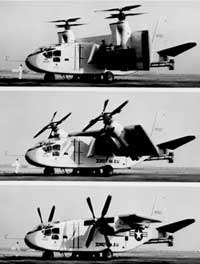Tiltwing

A tiltwing aircraft features a wing that is horizontal for conventional forward flight and rotates up for vertical takeoff and landing. It is similar to the tiltrotor design where only the propeller and engine rotate. Tiltwing aircraft are typically fully capable of VTOL operations.[1]
The tiltwing design offers certain advantages in vertical flight relative to a tiltrotor. Because the slipstream from the rotor strikes the wing on its smallest dimension, the tiltwing is able to apply more of its engine power to lifting the aircraft. For comparison, the V-22 Osprey tiltrotor loses about 10% of its thrust to interference from the wings.[2] However, the fixed wing of a tiltrotor aircraft offers a superior angle of attack—thus more lift and a shorter takeoff roll—when performing STOL/STOVL operations. The main drawback of the tiltwing is control during hover. The wing tilted vertically represents a large surface area for crosswinds to push.[1] Tiltrotors generally have better hover efficiency than tiltwings, but less than helicopters.[3]
As of 2014, NASA is testing a diesel-electric hybrid 10-foot 10-rotor tiltwing called the GL-10 Greased Lightning, with most propellers folding during horizontal flight.[4]
List of Tiltwing aircraft
Tiltwing designs with rocket, jet, or propeller propulsion
- 1957 – Vertol VZ-2
- 1959 – Hiller X-18
- 1964 – LTV XC-142
- 1965 – Canadair CL-84
See also
References
- 1 2 Markman, Steve and Bill Holder. "Tilt-Wing VTOL Systems". Straight Up: A History of Vertical Flight. Schiffer Publishing, 2000. ISBN 0-7643-1204-9.
- ↑ Boeing looks ahead to a 'V-23' Osprey
- ↑ Warwick, Graham. "Tilting at targets" page 44 Flight International, February 1992. Accessed: 4 January 2014.
- ↑ Warwick, Graham. "Distributed power" Aviation Week & Space Technology page 31, 25 August 2014. Accessed: 26 August 2014.
| ||||||||||||||||||||||||||||||||||